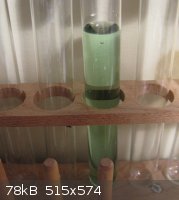| Pages:
1
2 |
Zyklon-A
International Hazard
    
Posts: 1547
Registered: 26-11-2013
Member Is Offline
Mood: Fluorine radical
|
|
Here are some ways to make Fe3O4:
C6H5NO2 + 3 Fe + 2 H2O → C6H5NH2 + Fe3O4.
3Fe2O3 + H2 → 2Fe3O4 +H2O.
3Fe2O3 + CO → 2Fe3O4 + CO2, however with that last one, there's also this: Fe3O4 + 4CO → 3Fe + 4CO2. So, if you use to much CO you'll end
up with metallic iron, (I think that reaction happens only at very high temps).
[Edited on 25-12-2013 by Zyklonb]
|
|
|
Zyklon-A
International Hazard
    
Posts: 1547
Registered: 26-11-2013
Member Is Offline
Mood: Fluorine radical
|
|
Quote: Originally posted by I am a fish  | You really need to find a pottery supplier. Are you absolutely certain there are none where you live?
Fe3O4 is produced by digging it out of the ground. The reason you can't find methods of synthesising it, is probably due to the fact that there is no
need to. |
Fe3O4 is so cheap that it is used in the production of Fe2O3: 2Fe3O4 + ½ O2 → 3(α-Fe2O3)
|
|
|
Boron Trioxide
Harmless

Posts: 42
Registered: 18-6-2012
Member Is Offline
Mood: No Mood
|
|
I have tried making Fe3O4 by the method described in this pdf, iron (II) sulfate is heated then reacted with a mixture of potassium nitrate and sodium
hydroxide.
This is supposed to convert the iron sulfate to green iron (II) hydroxide that would be then oxidized to Fe3O4.
However when trying this myself the mixed solution turns the color of tea and then slowly precipitates Fe2O3, any ideas on what I did wrong.
Note: I used a solution of iron sulfate produced by reacting copper sulfate with iron. This produced a nice green solution, also the hydroxide was in
solution and was produced through the electrolysis of sodium chloride, its pH was checked to be around pH 13-14.
Sorry I didn't think to take any pictures of the reaction.
Also I did this reaction a few days ago, and when I rechecked the pH on my sodium hydroxide it was neutral after being stored in glass for a day any
idea why?
If anyone else succeeds with this method let us know.

Attachment: magnetite_Synthesis.pdf (124kB)
This file has been downloaded 739 times
|
|
|
Zyklon-A
International Hazard
    
Posts: 1547
Registered: 26-11-2013
Member Is Offline
Mood: Fluorine radical
|
|
NaOH(aq) with only 13-14 Ph is not very much NaOH in solution, did you use a salt bridge to make it from NaCl? Otherwise it will have the Cl- ion
which may be responsible for the green color, I don't know why it made Fe2O3, maybe because there was not an adequate amount of NaOH? Find out how
pure your NaOH is, I tried to make NaOH that way, and I could never get it to work right.
Edit: It is no longer high PH because ferrous sulfate is the product of ferrous hydroxide and sulfuric acid.
Ferrous hydroxide is a weak base, and sulfuric acid is a strong acid, so you would expect ferrous sulfate to be acidic.
[Edited on 3-1-2014 by Zyklonb]
|
|
|
Boron Trioxide
Harmless

Posts: 42
Registered: 18-6-2012
Member Is Offline
Mood: No Mood
|
|
That is a good point, I didn't use a salt bridge to produce the NaOH, I had thought the excess Cl ions wouldn't effect it. I will try again when I am
able and will use a salt bridge.
By the way I should have specified the picture I posted was of the Fe(II)SO4 in solution. I also have a more concentrated solution of this though it
is more of a yellowish color more representing the pdf's pictures.
[Edited on 3-1-2014 by Boron Trioxide]
|
|
|
Zyklon-A
International Hazard
    
Posts: 1547
Registered: 26-11-2013
Member Is Offline
Mood: Fluorine radical
|
|
Make a salt bridge.
Make a simple salt bridge.
It says use KNO3, but if you don't have any, NaCl will also work. (Although not as well.)
[Edited on 3-1-2014 by Zyklonb]
|
|
|
Zyklon-A
International Hazard
    
Posts: 1547
Registered: 26-11-2013
Member Is Offline
Mood: Fluorine radical
|
|
I copied this exactly and it worked except, I couldn't get a power supply that worked well enough to be effective.
Be careful as chlorine gas is given off, however it won't get so bad that you'll be poisoned, if you can't smell it you'er fine, if you can, just put
it outside and don't inhale it.
[Edited on 4-1-2014 by Zyklonb]
|
|
|
| Pages:
1
2 |